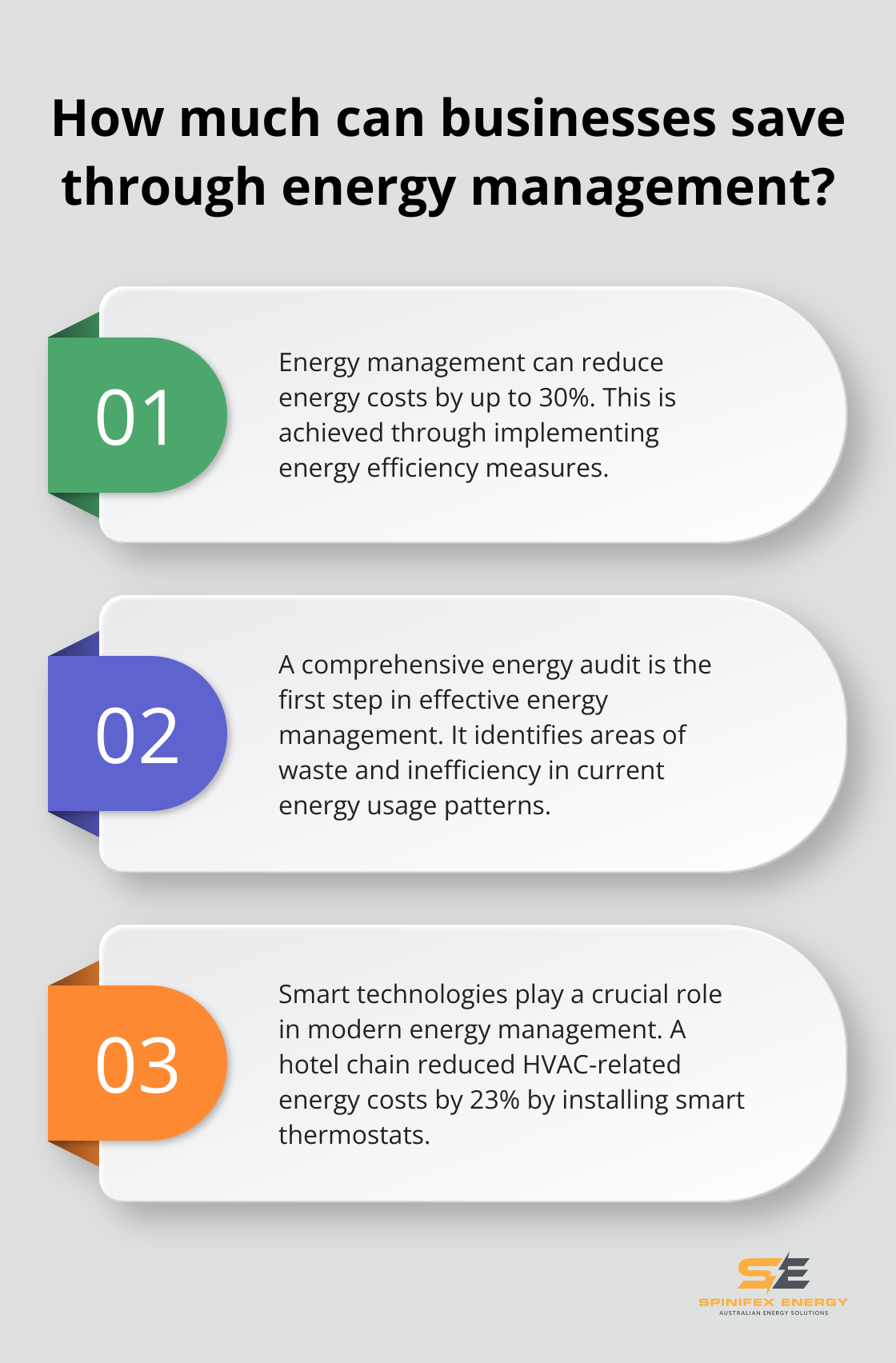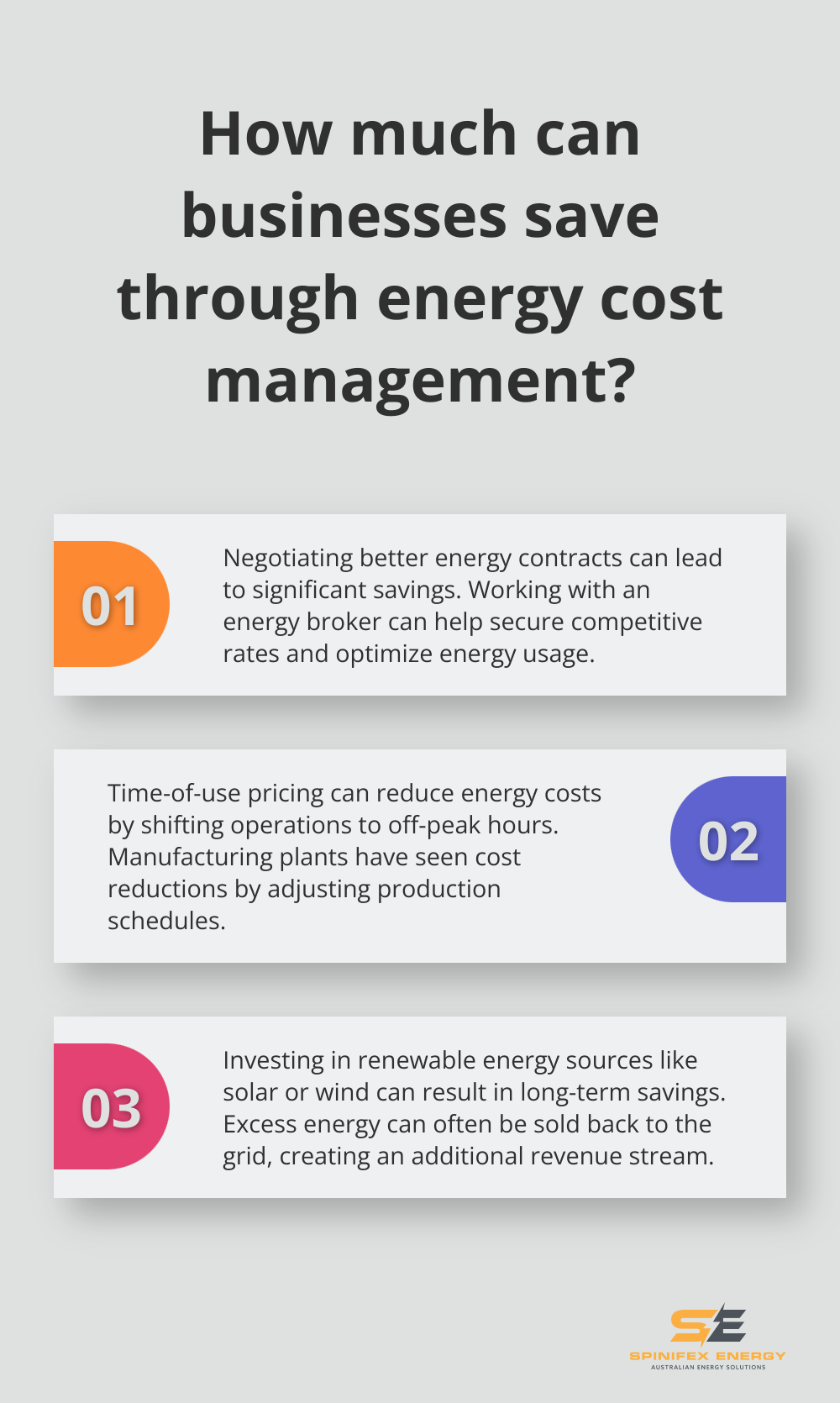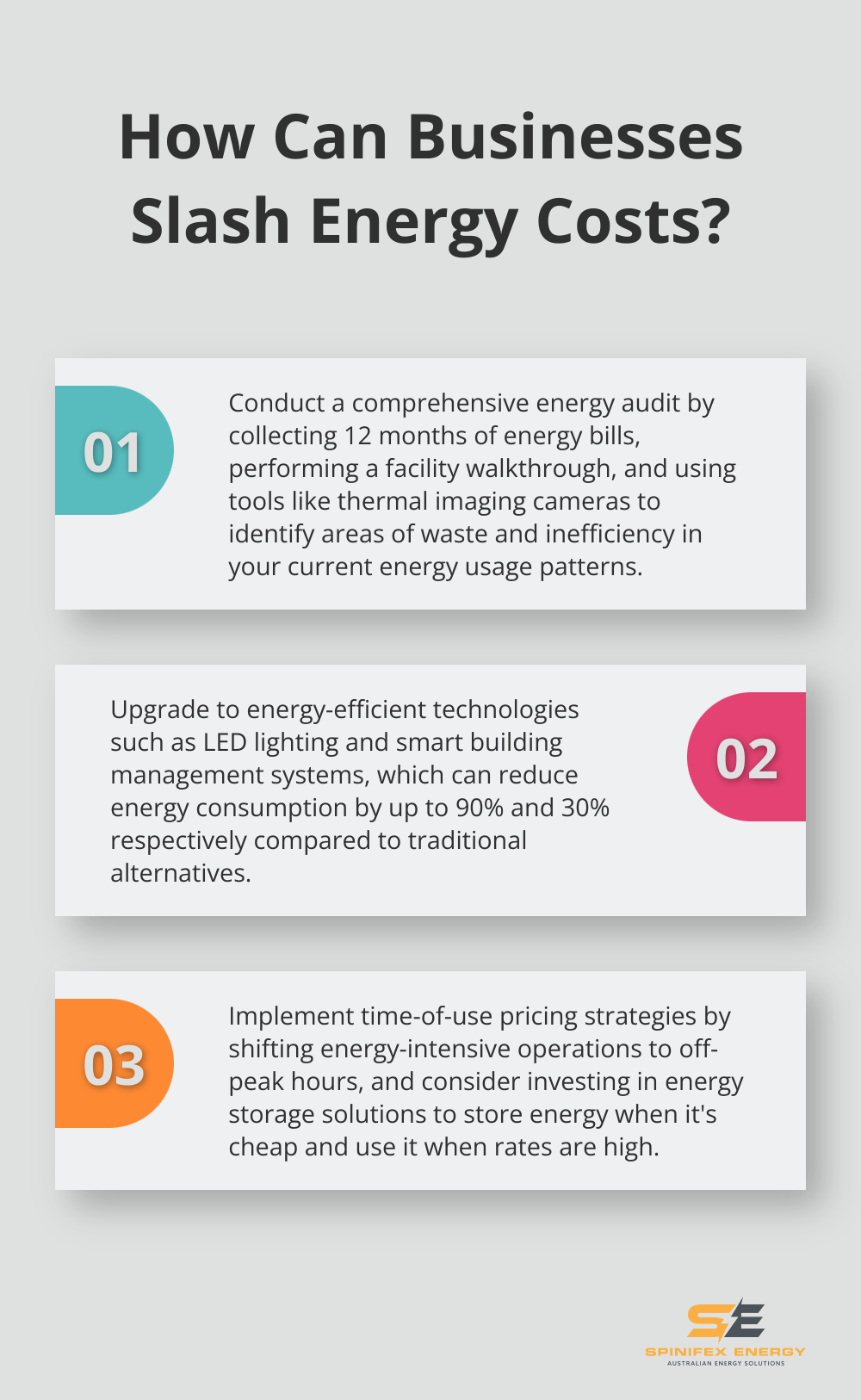Energy management and efficiency are critical for businesses looking to reduce costs and minimize their environmental impact. At Spinifex Energy, we’ve seen firsthand how effective energy management strategies can transform operations and boost bottom lines.
In this post, we’ll explore practical ways to balance efficiency and cost in your energy management approach. From conducting energy audits to implementing cutting-edge technologies, we’ll cover actionable steps you can take to optimize your energy use and save money.
What Is Energy Management?
The Core of Energy Management
Energy management can reduce energy costs through energy efficiency measures. This can increase the profitability of businesses. It focuses on using energy more efficiently to reduce costs and environmental impact. Some businesses have slashed their energy bills by up to 30% through effective management strategies.
Key Components of an Effective Strategy
An effective energy management strategy starts with a comprehensive energy audit. This analysis identifies areas of waste and inefficiency in current energy usage patterns. For example, a manufacturing plant discovered that their outdated lighting system accounted for 20% of their total energy consumption.

Setting clear, measurable goals follows the audit. These goals range from reducing overall energy consumption by a specific percentage to achieving certain sustainability targets. A mid-sized office building set a goal to reduce their energy use by 15% within a year and exceeded it, reaching an 18% reduction.
Technology: A Game-Changing Factor
Modern energy management relies heavily on energy-efficient technologies. Smart meters and energy management systems provide real-time data on energy consumption, allowing for immediate adjustments. A hotel chain installed smart thermostats in all rooms, resulting in a 23% reduction in HVAC-related energy costs.
Triple Bottom Line Benefits
Effective energy management cuts costs, boosts environmental credentials, and improves operational efficiency. A food processing plant reduced their carbon emissions by 40% through a combination of energy-efficient equipment upgrades and process optimization.
Businesses that prioritize energy management often see improved employee engagement. Staff involvement in energy-saving initiatives fosters a culture of sustainability that can extend beyond the workplace.
The Importance of Continuous Improvement
Energy management requires ongoing monitoring and adjustment. The most successful businesses treat energy management as a continuous process, regularly reviewing and updating their strategies to keep pace with technological advancements and changing energy markets.
As we move forward, let’s explore specific strategies for improving energy efficiency (including conducting energy audits and implementing energy-efficient technologies). These practical steps will help you optimize your energy use and achieve significant cost savings.
How to Boost Energy Efficiency
Conduct Comprehensive Energy Audits
Energy audits form the foundation of any successful efficiency strategy. These assessments provide a detailed picture of your energy usage, identifying areas of waste and opportunities for improvement. An energy audit can clarify your company’s energy consumption and identify areas for potential savings. It can lead to reduced energy use and improved efficiency. To conduct an effective audit, start by collecting at least 12 months of energy bills. Next, perform a walkthrough of your facility, noting all energy-consuming equipment and their usage patterns. Use tools like thermal imaging cameras to detect heat loss and infrared scanners to identify electrical issues.
Upgrade to Energy-Efficient Technologies
Implementing energy-efficient technologies reduces consumption powerfully. LED lighting, for example, uses up to 90% less energy than traditional incandescent bulbs and lasts up to 25 times longer. Smart building management systems are another game-changer. These systems use sensors and automation to optimize energy use in real-time. A study by the American Council for an Energy-Efficient Economy found that smart building technologies can reduce energy use by 18-30%.
Optimize HVAC and Lighting Systems
HVAC systems often account for a large portion of a building’s energy use. Regular maintenance, such as cleaning or replacing filters and checking for duct leaks, can improve efficiency by up to 15%. Installing programmable thermostats or a building automation system can further reduce HVAC energy use by 10-30%.

For lighting, consider daylight harvesting systems that adjust artificial lighting based on available natural light. These systems can cut lighting energy use by 20-60% (according to the Lighting Controls Association). Motion sensors in less frequently used areas can also lead to significant savings.
Foster Employee Engagement
While technology plays a key role, human behavior is equally important. Engaging employees in energy-saving initiatives can lead to substantial reductions in energy use. The Carbon Trust estimates that employee engagement programs can reduce energy consumption by 5-10%.
Start by educating staff about the importance of energy efficiency and how their actions impact consumption. Create a green team to champion energy-saving initiatives. Implement simple policies like turning off lights and equipment when not in use.
Improving energy efficiency requires an ongoing commitment. Regular monitoring of your energy use, setting new goals, and staying informed about emerging technologies and best practices will help you achieve significant energy savings. As we move forward, let’s explore how these efficiency measures translate into tangible cost savings for your business.
How to Cut Energy Costs
Negotiate Better Energy Contracts
Don’t accept the first energy contract offered. Compare offers from multiple providers. Look for contracts with flexible terms that allow you to benefit from market fluctuations. Consider working with an energy broker who can act as an intermediary between energy suppliers and businesses, helping to negotiate contracts, secure competitive rates, and optimize energy usage.
Take Advantage of Time-of-Use Pricing
Many utility companies offer time-of-use pricing, where rates vary depending on the time of day. Shift energy-intensive operations to off-peak hours to reduce your energy costs significantly. For instance, a manufacturing plant that shifted its production schedule to run heavy machinery during off-peak hours saw a reduction in energy costs.
Invest in Renewable Energy
While upfront costs can be significant, investing in renewable energy sources like solar or wind can lead to substantial long-term savings. Excess energy generated can often be sold back to the grid, creating an additional revenue stream.
Implement Energy Storage Solutions
Energy storage systems (such as batteries) allow you to store energy when it’s cheap and use it when rates are high. This strategy is particularly effective when combined with renewable energy sources. Hybrid renewable energy systems (HRESs) typically consist of renewable energy as the primary sources plus batteries and/or diesel generators as a backup.
Utilize Energy Management Software
Advanced energy management software provides real-time insights into your energy usage, helping you identify inefficiencies and optimize consumption. These systems can automate energy-saving measures, such as adjusting HVAC settings based on occupancy or weather conditions.
Participate in Demand Response Programs
Many utilities offer demand response programs where they pay businesses to reduce their energy use during peak demand periods. Participation in these programs can not only reduce your energy costs but also earn additional revenue.

Implementing these cost-saving measures requires expertise and ongoing management. Energy consultants provide tailored solutions that optimize energy procurement, implement advanced technologies, and ensure you’re taking advantage of all available cost-saving opportunities. With a data-driven approach, you can focus on your core business while experts handle the complexities of energy management.
Final Thoughts
Energy management and efficiency strategies are essential for businesses to thrive in today’s competitive landscape. Companies can significantly reduce their energy consumption and costs through comprehensive audits, technology upgrades, and system optimizations. These efforts lead to improved operational efficiency, enhanced brand reputation, and increased resilience to energy market fluctuations.

Effective energy management requires continuous monitoring, analysis, and improvement as technology evolves and energy markets shift. Businesses must stay informed and adaptable to maintain their competitive edge. Regular reassessment of energy strategies ensures companies continue to optimize their energy use and contribute to global sustainability efforts.
Expert guidance can prove invaluable for businesses navigating the complexities of energy management. Spinifex Energy specializes in tailored energy consulting services that help businesses optimize their electricity expenses through proactive energy procurement, advanced commercial solar power systems, and innovative battery storage solutions. Our data-driven approach aims to maximize savings and efficiency for our clients.

